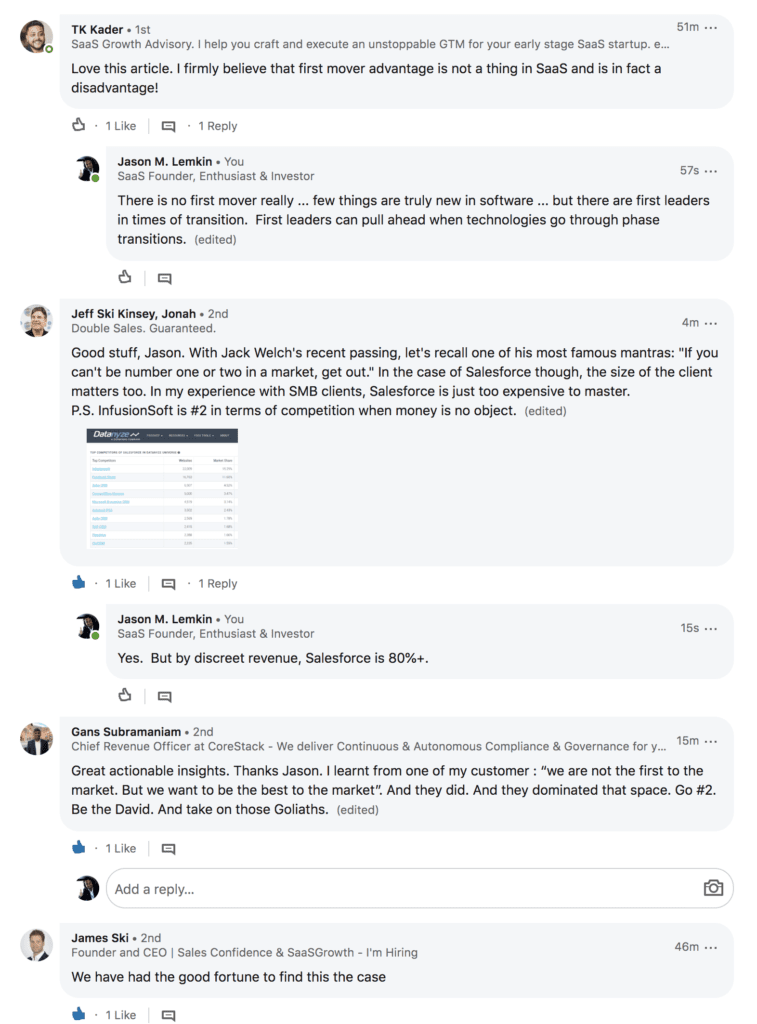 I used to hate the idea of “power laws”. That the advantages of being #1 compound over time. It seemed to turn all startups into just numbers on a graph.
I used to hate the idea of “power laws”. That the advantages of being #1 compound over time. It seemed to turn all startups into just numbers on a graph.
But has time has gone on, I’ve learned it’s often right. Just look at Zoom’s incredible run to dominate an existing category. Being #1 in a category often takes 80%-90% of the value and benefits.
Except … except when it doesn’t:
- Except, e.g., where Squarespace and Wix are both billion+ companies. Doing sort of kind of the same thing.
- Except with Salesloft and Outreach both are winning in the same space, each with dominant market share.
- Except when Mailchimp can do $1b in ARR, but you turn around and Klaviyo is doing $100m. When in a large space, segments alone can be huge.
And in fact, in turns out in some cases, there are some advantages to being #2. At least, there is a playbook that you can play that #1 can’t.
And if you’re #2 and growing faster than #1, then that’s still a pretty strong place to be. Given enough time, you just might catch them. Or at a bare minimum, build something at least as big or bigger than they’ve built.
In fact, tactically at least, there are a lot of advantages to being #2:
- #2 Can Win With Better Technology / Better App. It’s really hard to enter an established space with a 30% better product. You ain’t gonna beat Salesforce with a brand new CRM that is 30% better. It has to be 10x to disrupt an entrenched dominant player. But, #2 can win with just a 30% better product than #1, if #2 is already a leader and in the game. Post-traction, with a brand. Then, it’s down to which is better for me, #1 or #2. #2 often has a better product, at least for some market segments.
- #2 Can Win as a Better Partner. See above. #1s can get arrogant, worst case. Best case, they start to think in terms of direct ROI in partnerships. Maybe the NASDAQ partnership above had questionable economics. I bet it did. JVs are complicated. But these deals are easier for #2s to take on.
- #2 Can Win on Innovation. This is closely related to the first point. Sometimes, #1 gets staid. Have they been around 7, 8 years? Not everyone is able to stay innovative after the first phase of the SaaS journey. You can focus on the future, while they are stuck in the present, and really, the present of about 2 years ago.
- #2 Has a Clear, Simple Target. If you’re #1, what’s your target? Just revenue growth. Yes, you worry about competition. But not as an existential target. But if you’re #2, you know exactly who you are gunning for, every hour of every day. It simplifies things and makes it easier to rally sales, product and marketing.
- #2 Can Take the Higher Ground and Be More Customer-Focused. When you’re #1, especially in sales … you end up trying to squeeze every last dollar out of the customers. As you should. And that does maximize short-term revenue. But, it also creates friction. If you’re #2, you don’t need to necessarily cut your prices. I don’t think you should. But your sales team will see prospects and leads as something more than just a numbers game. You’ll care more. This can pay off 18-24 months out.
- #2 Can Get Better Economics. Sometimes, #1 takes all the capital and air out of the space. But sometimes, they set the stage for you — and drive you leads. You come in, you can build your product more efficiently (you already have a roadmap), and leverage the multiples #1 has already established. You may end up with less dilution and better economics. To make this playbook work (they drive you leads), though, you generally have to be the clear alternative.
- #2 Can Grab the Customers that #1 Cares Less About. This is how so many new entrants win. The Big Guy gets to $50m, $100m, $1000m ARR … and just can’t care as much about certain segments. #2 can.
- #2 Can Go Down Market Easier. I’ve seen this a lot. It’s hard to go downmarket in general. You get good at a certain price point, you optimize around it, and while you can tilt upmarket … the DNA just isn’t there to go downmarket, at least not to monetize it effectively. #2 often finds whitespace one market level below #1. Then, the overall market for your products grow. And it eventually grows even faster downmarket … which #2 becomes well positioned to take advantage of.
Just some thoughts. Again, I have no idea who is #2 to Salesforce in ondemand CRM. Sometimes, #1 does eat everything.
But not always.
note: a 2020 update of a class 2013 post
The post The Virtues and Opportunities in Being #2 appeared first on SaaStr.
via https://ift.tt/2Jn9P8X by Jason Lemkin, Khareem Sudlow

